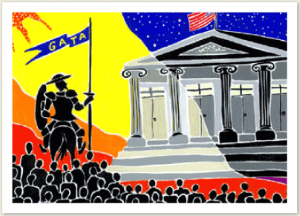 GATA long has maintained that the “strong-dollar policy” was mainly gold price suppression, implemented largely through the gold carry trade devised by President Clinton’s treasury secretary, former Goldman Sachs Chairman Robert Rubin, an enterprise in which Western central banks “leased” gold to investment banks at negligible interest rates and encouraged them to sell the metal and invest the proceeds in U.S. government bonds paying closer to 5 percent. The investment banks thereby collected a spread that was risk-free as long as they had the assurance that, as Federal Reserve Chairman Alan Greenspan told Congress in July 1998, “central banks stand ready to lease gold in increasing quantities should the price rise“.
GATA long has maintained that the “strong-dollar policy” was mainly gold price suppression, implemented largely through the gold carry trade devised by President Clinton’s treasury secretary, former Goldman Sachs Chairman Robert Rubin, an enterprise in which Western central banks “leased” gold to investment banks at negligible interest rates and encouraged them to sell the metal and invest the proceeds in U.S. government bonds paying closer to 5 percent. The investment banks thereby collected a spread that was risk-free as long as they had the assurance that, as Federal Reserve Chairman Alan Greenspan told Congress in July 1998, “central banks stand ready to lease gold in increasing quantities should the price rise“.
Gold leasing gave the U.S. government a strong dollar, strong government bond prices, and low interest rates even as the government’s debt began to explode under Presidents Bush and Obama. For inflation was safely concealed behind a gold price that was suppressed by artificial and imaginary supply.
So if the U.S. government wants a weaker dollar, it probably needs only to curtail gold leases and swaps and take some central bank feet off the gold market, feet that seem to have been stomping on gold pretty hard lately, given the explosion of gold swapping through the Bank for International Settlements over the last year.
This easing of gold price suppression probably can be done without prompting any suspicion from mainstream Western financial news organizations, which are either brain-dead or as compliant as news organizations in totalitarian countries. Tonight only Marketwatch seems to have come across a hint of what the “strong-dollar policy” was really about. Of the Rubin years at Treasury, Marketwatch writes:
“The Clinton administration’s tune soon changed once Rubin replaced Bentsen. Rubin drove home the shift by faithfully repeating that a strong dollar was in America’s interest. Some well-timed intervention that burned the fingers of dollar bears also helped.”
This post was published at GATA

 Follow on Twitter
Follow on Twitter
Recent Comments